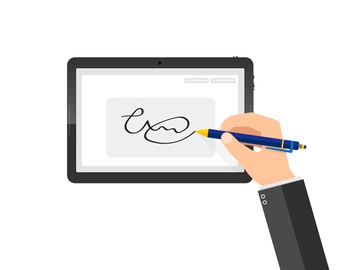Introduction
The use of signs, symbols and words to represent one’s identity has been the part of human history from a long time. Being unknown to words in the stone age, mankind drew pictures on the cave walls and later to express his identity he started writing his name or depicting it through symbols. These signs and symbols were often unique to an individual.
Today, signatures have assumed much importance, we sign numerous times in the course of our daily life. For illiterate people, their thumbprint becomes their signature as it is unique for every individual.
International Law dealing with E-signatures
The United Nations in 1998 made an observation that increasing transactions in cyberspace over the recent years made it very necessary to have a legal framework dealing with E-signatures. Also, there existed much ambiguity regarding the legal effect of such authorizations from concerned individuals and the courts in various countries regularly tussled with the issue. Thus, a uniform legislative approach was adopted to deal with the problem.
As a result, the UNCITRAL Model Law on Electronic Signatures, 2001 was adopted. This comprehensive document inter alia laid down certain basic guidelines and procedures to be followed by member nations while formulating the law on E-signatures in their respective parliaments.
There are certain requirements of an electronic signature which every nation needs to ensure in their local laws, these are enshrined under Article 6 of the UNCITRAL Model law:
- Reliability:The first requisite is that the E-signature has to be reliable, for being reliable as well there are certain criteria. An E-signature can only be considered reliable if it has following:
- Retraceable: The technique used in making the technology is such that it can be easily linked to the original source(creator) the message whenever necessary.
- Controllable:The technique used must be such that it is under the control of the source.
Further, the technology should be such that any unwarranted alteration of the important data can be easily detected even after the signature has been affixed. Today, The UNCITRAL Model law on electronic signatures is the most comprehensive document dealing with e-signatures at length.
Techniques to make e-signature
There are numerous techniques employed all over the world to make E-signatures, UNCITRAL model prescribes a list of valid techniques. The basic technology at work in designing E-signatures is of cryptography. Cryptography is the widely used phenomena to secure important messages and has been in use for a long time. Under cryptography, the message that needs to be preserved is encrypted or codified into a format which is unreadable for the ordinary people and only the individual having the requisite know-how of decrypting the code can read it.
Advantage of E-Signature
- Identity:Electronic signatures help an individual to gain identity in the digital world. It signifies an approval from him/her which is unique in nature and can’t be misused.
- Secure:Electronic signatures being digital in nature and made by cryptographic technology cannot be validated by ordinary authentication procedures. Thus, the chances of tampering with it are minimal.
- Swift:It being digital based, makes the work fast and hassle free. Due to this E-signature are today widely used in the corporate arena where companies want the work to be fast and secure. In most cases, the complete approval of documents is done in a matter of minutes, unlike days or hours in usual paperwork.
- Record-keeping:E-signatures help in better maintenance of personal records of an individual. Many nation-wide entrance exams in our country today make use of E-signatures for upload of individual documents.

